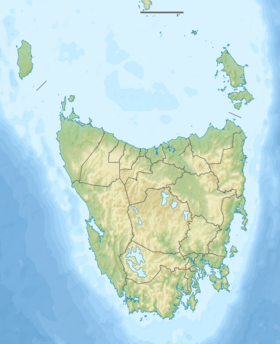John Butters Power Station
| John Butters Power Station | |
|---|---|
 Location of John Butters Power Station in Australia Tasmania | |
| Country | Australia |
| Location | Western Tasmania |
| Coordinates | 42°09′21″S 145°32′04″E / 42.15583°S 145.53444°ECoordinates: 42°09′21″S 145°32′04″E / 42.15583°S 145.53444°E |
| Purpose | Power |
| Status | Operational |
| Opening date | 1991 |
| Owner(s) | Hydro Tasmania |
| Dam and spillways | |
| Type of dam | Embankment dam |
| Impounds | King River |
| Height | 83 metres (272 ft) |
| Length | 245 metres (804 ft) |
| Width (crest) | 300 millimetres (12 in) |
| Dam volume | 770×103 m3 (27×106 cu ft) |
| Spillways | 1 |
| Spillway type | Controlled and uncontrolled |
| Spillway capacity |
|
| Reservoir | |
| Creates | Lake Burbury |
| Total capacity | 1,081,420 ML (38,190×106 cu ft) |
| Active capacity | 1,065,000 ML (37,600×106 cu ft) |
| Catchment area | 559 km2 (216 sq mi) |
| Surface area | 53,250×103 m2 (573.2×106 sq ft) |
| Power station | |
| Name | John Butters Power Station |
| Operator(s) | Hydro Tasmania |
| Commission date | 1992 |
| Type | Conventional |
| Hydraulic head | 184 metres (604 ft) |
| Turbines |
1 x 144 MW (193,000 hp) Fuji Francis turbine |
| Installed capacity | 144 megawatts (193,000 hp) |
| Capacity factor | 0.9 |
| Annual generation | 576 gigawatt-hours (2,070 TJ) |
|
Website hydro | |
| [1] | |
The John Butters Power Station is a conventional hydroelectric power station located in Western Tasmania, Australia. The power station forms part of the King – Yolande River Power Scheme and is owned and operated by Hydro Tasmania.[2]
Technical details
Part of the King – Yolande scheme that comprises three hydroelectric power stations, the John Butters Power Station is fed by water from Lake Burbury which is dammed by the Crotty Dam in the gap in the West Coast Range between Mount Jukes and Mount Huxley, and to the south by Darwin Dam. Water flow to the station is via a long headrace tunnel from the Crotty Dam via a 6.5-kilometre (4.0 mi)-long headrace tunnel and a 500-metre (1,600 ft)-long steel lined power tunnel.[3]
The power station was commissioned in 1992 by the Hydro Electric Corporation (TAS), one of the last power stations constructed before its disaggregation and transformation to Hydro Tasmania.[4]:327–347 The station has one Fuji Francis turbines with a generating capacity of 144 megawatts (193,000 hp) of electricity. Within the station building, the turbine has a half embedded spiral casing controlled via a spherical rotary inlet valve and a vertical lift, gravity closed intake gate designed to cut off full flow. The station output, estimated to be 576 gigawatt-hours (2,070 TJ) annually,[1] is fed to TasNetworks' transmission grid via a 13.8 kV/220 kV three-phase Fuji generator transformer to the outdoor switchyard.[3]
The station is remotely controlled from the Sheffield Control Centre.[5]
Etymology
The power station was named in honour of John Butters, the first general manager and chief engineer of Hydro Tasmania.[4]:34–49[6]
When the King power scheme was approved by the Tasmanian Government the name on hydro plans for the proposed power station at that time was the 'Newell Power station'.[7]
See also
References
- 1 2 "Register of Large Dams in Australia" (Excel (requires download)). Dams information. Australian National Committee on Large Dams. 2010. Retrieved 23 June 2015.
- ↑ "King - Yolande". Energy: Our power stations. Hydro Tasmania. Retrieved 21 June 2015.
- 1 2 "John Butters Power Station: Technical fact sheet" (PDF). King - Yolande Catchment. Hydro Tasmania. Retrieved 6 July 2015.
- 1 2 Lupton, Roger (1999). Lifeblood: Tasmania's hydro power. Focus Publications. ISBN 978-1-875359-33-2.
- ↑ King River Power Development. Hydro Tasmania. pp. 11 and 13.
- ↑ Felton, Heather; Hydro Tasmania (2008), Ticklebelly tales and other stories from the people of the Hydro, Hydro Tasmania, pp. 16–17, ISBN 978-0-646-47724-4
- ↑ "Crotty Dam, Tasmania" (PDF). Submission for historic engineering marker. Engineers Australia. September 2000.